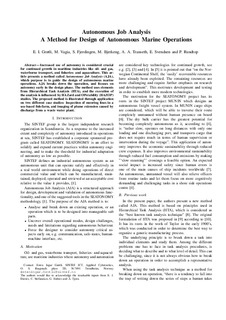| dc.contributor.author | Grøtli, Esten Ingar | |
| dc.contributor.author | Vagia, Marialena | |
| dc.contributor.author | Fjerdingen, Sigurd Aksnes | |
| dc.contributor.author | Bjerkeng, Magnus Christian | |
| dc.contributor.author | Transeth, Aksel Andreas | |
| dc.contributor.author | Svendsen, Eirik | |
| dc.contributor.author | Rundtop, Per | |
| dc.date.accessioned | 2016-01-27T10:47:06Z | |
| dc.date.accessioned | 2016-01-29T08:23:03Z | |
| dc.date.available | 2016-01-27T10:47:06Z | |
| dc.date.available | 2016-01-29T08:23:03Z | |
| dc.date.issued | 2016 | |
| dc.identifier.citation | OCEANS 2015 | nb_NO |
| dc.identifier.issn | 0197-7385 | |
| dc.identifier.uri | http://hdl.handle.net/11250/2375212 | |
| dc.description | - | nb_NO |
| dc.description.abstract | Increased use of autonomy is considered crucial
for continued growth in maritime industries like oil- and gas, waterborne transport, and fisheries- and aquaculture. This article presents a method called Autonomous Job Analysis (AJA), which purpose is to guide the design of autonomous marine operations. AJA breaks down the operation, and focuses on autonomy early in the design phase. The method uses elements from Hierarchical Task Analysis (HTA), and the execution of the analysis is influenced by HAZard and OPerability (HAZOP) studies. The proposed method is illustrated through application on two different case studies: Inspection of mooring lines in a sea-based fish-farm, and imaging of plume extension caused by
discharge from a waste water plant. | nb_NO |
| dc.language.iso | eng | nb_NO |
| dc.title | Autonomous Job Analysis: A Method for Design of Autonomous Marine Operations | nb_NO |
| dc.type | Journal article | nb_NO |
| dc.date.updated | 2016-01-27T10:47:06Z | |
| dc.identifier.cristin | 1323699 | |
